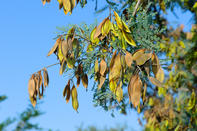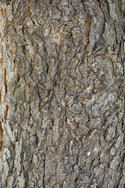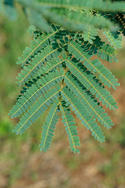
African Weeping-wattle Appearance
The weeping-wattle gets the weeping part of its name from the fact that it harbours spittle-bugs. These small sap-sucking insects tap moisture from the stems of the weeping-wattle so rapidly that it is excreted almost as quickly as it is ingested. Some of the fluid is frothed into a protective coating against the sun and predators but the copious liquid drips off the spittle bugs and gives the impression that the tree is weeping.
The wood of the weeping-wattle is fairly versatile and is used to produce furniture as well as finer articles such as ornaments or functional tools like axe handles. The weeping-wattle has very large feathery twice-compound leaves that have a lovely velvety feel to them.
The flowers are bright yellow with crinkly petals and create a spectacular show when they emerge in clusters on the trees. They are also sweet to the nose and these features make the tree a particularly suitable specimen for growing in the garden (in areas where frost doesn’t occur). Nectar loving insects such as bees visit the tree when it’s in flower as do insectivorous birds which feed on the insects.
The pod is a woody tear-shape with a bulge where the seed sits in the middle. The bark of the weeping-wattle is dark and fissured long-ways and the younger steams are covered in red-brown hairs (as are most of the other parts of the tree).
African Weeping-wattle Uses

The bark is traditionally chewed to relieve colic and a decoction of the bark and leaves helps to exterminate internal parasites. The steam of hot decoctions of bark is used to treat sore eyes. This is not a particularly popular browse plant and few indigenous herbivores use it extensively. Cattle and goats are fairly partial to the younger leaves and will eat the pods.
The root of the weeping-wattle has proven most useful to the local Africans medicinally. Powdered it can be applied to wounds to speed up healing. As an infusion (i.e. soaked in water) it may be consumed to relieve stomach problems or cure infertility in women.
As a decoction (i.e. boiled in water) it may be used as a gargle to treat sore throats or when swallowed as a remedy for venereal disease. A sprinkling of the decoction in the home is said to keep witches at bay. A body wash can be made from the infused root and is said to cure body swelling (oedema) and made from the whole plant can treat the insane.
It has been suggested that the leaves are the most suitable of all bushveld trees for use as toilet paper due to their softness. One does have to consider using more than one ply however and be careful not to confuse the tree with one of the thorny Acacia’s which may have similar leaves!
African Weeping-wattle Fast Facts

Height - 10 to 15 m
Growth form - Single-stemmed but low-branching with untidy canopy
Leaf type - Bi-pinnately compound
Leaf arrangement - Alternate
Leaf margin - Entire
Habitat - Well-drained soils in woodland and along the edges of vleis
Deciduous or not - Deciduous
Most notable fruit/flowering season - Sept to Feb (flowers)
By Megan Emmet